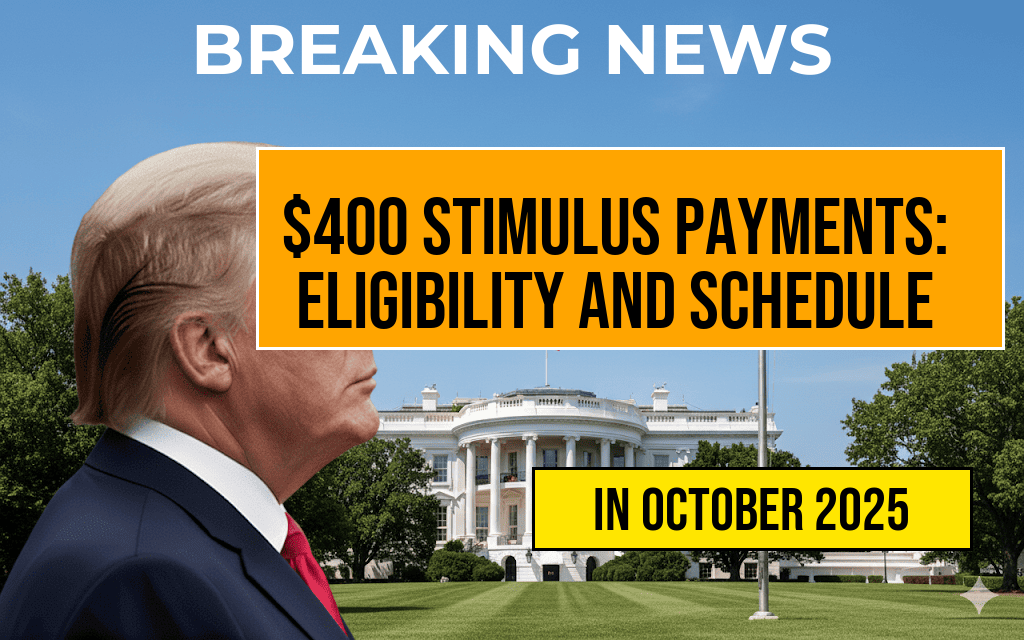The recent announcement regarding a new round of $400 stimulus payments has sparked interest and inquiries among eligible citizens. As states continue to grapple with the economic impacts of the pandemic, these payments aim to provide financial relief to those in need. This guide will help clarify the eligibility requirements and the payment schedule for recipients, ensuring that individuals can effectively navigate the process and understand their rights to these funds.
Eligibility Requirements for $400 Stimulus Payments
To qualify for the $400 stimulus payment, individuals must meet specific criteria. The following sections outline the key requirements:
- Income Thresholds: Applicants must fall below a certain income level, typically defined by the federal poverty guidelines. For single filers, the limit is generally set around $75,000, while for married couples, it may extend to $150,000.
- Residency: Eligible recipients must be residents of states that have opted into the stimulus program. Each state may have different guidelines, so it’s critical to check local regulations.
- Tax Filing Status: Individuals who filed taxes in the previous year are usually prioritized for these payments. Those who did not file taxes may still qualify but might need to provide additional documentation.
- Dependent Status: Individuals with dependents may receive additional payments, but the amount can vary based on family size and income.
How to Apply for the $400 Stimulus Payment
Applying for the stimulus payment is a straightforward process, but it varies by state. Here’s a general outline of the steps involved:
- Check Eligibility: Before applying, confirm that you meet all eligibility requirements as outlined above.
- Visit State Government Website: Each state has a dedicated portal for stimulus payments. Access your state’s official website to find detailed instructions.
- Complete Application: Fill out the required application forms. Be prepared to submit documents such as your Social Security number, proof of income, and residency.
- Submit Application: After completing the forms, submit your application before the specified deadline. Ensure you retain a copy for your records.
Payment Schedule
The timing of the $400 stimulus payments may differ based on the state’s implementation plan. Below is a general outline of the expected payment schedule:
| State | Expected Payment Date |
|---|---|
| California | March 15, 2024 |
| Texas | April 1, 2024 |
| Florida | April 15, 2024 |
It’s advisable for applicants to monitor their state’s announcements regularly, as payment dates may change based on legislative actions or budgetary considerations.
Frequently Asked Questions
What if I miss the application deadline?
Missing the deadline may disqualify you from receiving the payment for this round. However, many states may offer subsequent rounds or alternative assistance programs. It’s best to stay informed through your state’s official communication channels.
Will I receive the payment directly in my bank account?
Depending on your state’s process, payments may be issued via direct deposit if you have previously provided banking information for tax purposes. Alternatively, checks may be mailed to your registered address.
Can I appeal if my application is denied?
Yes, most states will have an appeal process in place. If your application is denied, carefully review the reasons provided and follow the guidelines for submitting an appeal.
For more detailed information about the $400 stimulus payments, including updates on eligibility and state-specific guidelines, you can visit Forbes or check the official state government resources.
Staying informed and proactive is key to ensuring that you receive the financial assistance you may be entitled to during these challenging times.
Frequently Asked Questions
What are the eligibility requirements for the $400 stimulus payments?
To qualify for the $400 stimulus payments, individuals generally need to meet specific income thresholds, residency criteria, and other factors set by the government. Typically, applicants must be U.S. residents and may need to have filed a tax return in the previous year.
When can I expect to receive my $400 stimulus payment?
The payment schedule for the $400 stimulus payments can vary depending on when the legislation is enacted and processed. Generally, payments are distributed in phases, starting with those who have direct deposit set up with the IRS.
Will I receive the $400 stimulus payment if I have outstanding debts?
In most cases, the $400 stimulus payment is protected from garnishment due to outstanding debts, but there may be exceptions based on state laws or specific debt types. It’s advisable to check with a financial advisor for your situation.
How will the $400 stimulus payment be distributed?
The distribution methods for the $400 stimulus payments typically include direct deposit to bank accounts, mailed checks, or prepaid debit cards. The method used will depend on how the IRS has processed your previous tax returns.
Can I track my $400 stimulus payment?
Yes, individuals can track their $400 stimulus payment status through the IRS website using the “Get My Payment” tool, which provides updates on when payments are scheduled to be sent or direct deposited.











